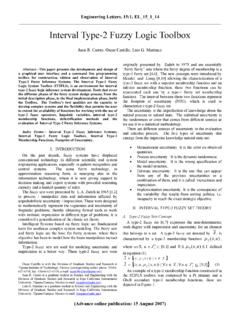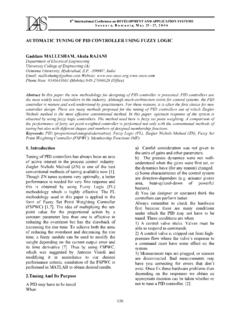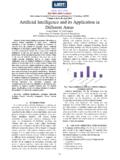Transcription of Fuzzy-PID Control via Genetic ... - Engineering Letters
1 Engineering Letters , 20:2, EL_20_2_08. _____. Fuzzy-PID Control via Genetic Algorithm-Based Settings for the Intelligent DC-to-DC. Step-Down Buck Regulation Anas N. Al-Rabadi and Mahmoud A. Barghash Abstract This article presents further testing and verification Using this small-signal model, the necessary open-loop results for a previously introduced new intelligent regulation transfer functions can be determined and plotted using Bode method that controls the power-electronic Buck converter plots in order to use compensation to the PWM power utilizing a small-signal model of the pulse width modulation (PWM) switch.
2 The implemented intelligent Control method uses converters, to meet the desired nominal operating conditions, a Fuzzy-PID controller that is tuned using the global search through the application of various Control methods. These method of Genetic algorithm (GA). The presented results further Control methods include: (a) frequency analysis in the classical verifies that the previously used intelligent hierarchical Control theory [32], (b) time analysis in the modern Control regulation method using the GA-tuned Fuzzy-PID controller theory [32], (c) both frequency analysis and time analysis produces the desired Buck performance for wide spectrum of domains in the post modern (digital and robust) Control theory, parameter values despite the occurrence of high amplitude noise.
3 And (d) soft computing ( , fuzzy logic , neural networks, and Index Terms Buck DC-to-DC converter, fuzzy Control , Genetic algorithms) in the intelligent Control methodology [2- Genetic algorithms, intelligent regulation, switching-mode step- 4, 8, 10, 13-15]. These Control methods can be applied to the down converter. models of power converters that usually work with only one specific Control scheme which is PWM through either duty- 1. INTRODUCTION ratio Control or current programming Control [31]. In this research, the duty-ratio Control is used, in which the switch Small-signal modeling of the open-loop power converters ON-time is controlled externally by comparing a saw tooth has recently received an increasing attention, due to the fact ramp with the controller voltage [31].
4 That these models are the basis to extract accurate transfer Several modeling approaches of the PWM power converters functions which are essential in the feedback Control design do exist. These approaches are separated into three main [7, 31]. They are used to design reliable high performance categories. The first modeling category aims towards regulators, by enclosing the open loop DC-to-DC power modeling the whole PWM converters. Examples for this converters in a feedback loop, to keep the function of the category are (a) volt-second and current-second (charge).
5 System as close as possible to the desired performance by balance approach and (b) state-space averaging approach [7, counteracting the outside noise in the (a) source voltages, (b) 31]. These approaches suffer from inaccurate results in the pulse width modulator (PWM) duty ratio, and (c) load current. high-frequency range. The second modeling category aims Power converters generally operate in (a) Continuous more specifically towards modeling what is called the Conduction Mode (CCM) or (b) Discontinuous Conduction converter cell, that includes modeling the basic cell of the Mode (DCM) [7, 31].
6 The CCM mode is desirable, as the PWM converter, and ignoring the input DC voltage source and output ripple of the DC-to-DC power converter is very small the output RC filter in the model, where the cell includes the when compared to the DC steady state output. A linearized PWM switch with the inductors and the capacitors associated small-signal model is constructed to examine the dynamic with it. An example for this category is the averaged modeling behaviors of the converter, due to the fact that noise is of small approach [7, 31].
7 This approach also suffers from inaccurate signal variations. results in the high-frequency range. The third modeling category aims more specifically to model the PWM switch. This work was accomplished with the support from the Deanship of Academic In general, the previously mentioned modeling approaches Research (DAR) at The University of Jordan under financial grant number utilize four techniques. The first technique is the sampled-data (733). representation technique. The second technique is the averaged technique. The third technique is the exact small- A.
8 N. Al-Rabadi (Corresponding Author) is currently an Associate Professor signal analysis technique [7, 31], and the fourth technique with the Computer Engineering Department at The University of Jordan, Amman-11942-Jordan; phone: +962 79 6445364; e-mail: combines the averaged technique and the sampled-data technique [7, 31]. The averaged technique represents the easiest and the most widely used technique. It can be used to M. A. Barghash is currently an Associate Professor with the Industrial determine the various impedances and transfer functions for Engineering Department at The University of Jordan; e-mail: the converters.
9 The basic characteristics of this technique are (1) it uses the averaging technique of voltages and currents (Advance online publication: 26 May 2012). Engineering Letters , 20:2, EL_20_2_08. _____. and (2) it gives accurate low-frequency results but inaccurate The global search heuristic called Genetic algorithm (GA). high-frequency results. mimics the process of natural evolution. This heuristic The production of averaged models can be accomplished algorithm is frequently used to generate useful solutions to for the nonlinear PWM switch as well for the converter system several optimizations and search problems that are widely as a whole.
10 This switch is usually a single-pole double-throw used in many applications such as in bioinformatics, (SPDT) switch. It is this switch which is responsible for computational sciences, economics, mathematics, physics, and switching the converter from one configuration to another Engineering [13-14, 18, 21-22, 24, 26-27, 29, 33, 36, 41-42, during each switching period. These models, derived for the 44, 48, 50]. Genetic algorithms belong to the larger class of PWM switch, are usually easier than the derivation of evolutionary algorithms (EA), which generate solutions to converter models.







